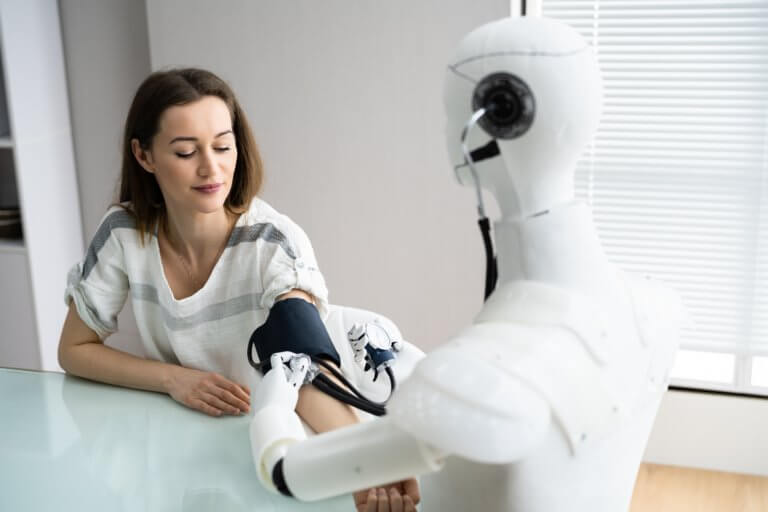The integration of robotics and AI is one of the most exciting advancements in the healthcare industry in recent years. From pharmacies to medical spas, healthcare experiences are increasingly incorporating robotics technology to improve patient care and efficiency. In this blog post, we’ll look at the future of robotics in healthcare through the lens of health-focused retail experiences.
Increased Convenience in Pharmacies
The pressure of convenience that robotics technology places on traditional pharmacies are clear. For example, PillPack by Amazon has implemented robotic systems to sort, count, and dispense medication, allowing them to fill prescriptions with remarkable speed and accuracy.
Customers are increasingly expecting a higher level of efficiency and accuracy in their interactions with healthcare providers, putting pressure on traditional pharmacies to keep up.


Image Source: AJP
Pharmacy Automation Supplies has also created a robotic dispensing system that can process up to 250 prescriptions per hour, demonstrating yet another advantage of automation in the pharmacy industry. ScriptPro provides a comparable solution, with a robotic dispensing system capable of holding up to 100,000 doses and processing prescriptions in seconds.
Since these automated systems have the potential to significantly improve pharmacy efficiency and accuracy, traditional pharmacies are under pressure to incorporate robotics technology into their operations.
The advantages of pharmacy automation are obvious, and the pressure to adapt will only increase as more customers come to expect a higher level of service. Pharmacies that do not use robotics risk falling behind their competitors and losing customers to more efficient and accurate providers. As a result, adopting robotics technology is not only a matter of staying competitive but also of meeting customer expectations.
Robotics in Aesthetic Medical Treatments
Robotics technology integration in the medical spa industry is transforming the patient experience and improving treatment outcomes. The use of advanced robotics systems in medical spas not only provides high-quality treatments but also lowers labor costs, which is a significant benefit for industry businesses.
Venus Concept is one company that has successfully integrated robotics into its operations. Their Venus Versa system performs laser hair removal, skin rejuvenation, and other treatments using advanced robotics. The system is designed to deliver optimal results while maintaining patient comfort, which is an important aspect of the medical spa experience.
The incorporation of robotics has enabled Venus Concept to improve treatment speed and efficiency, resulting in better outcomes for patients and increased revenue for the company.


Image Source: Ideal Esthetics
Another company that has developed robotic solutions for the medical spa industry is EndyMed Medical. Their Intensif device employs automated technology to deliver micro-needling treatments that can reduce the visibility of fine lines and wrinkles. This device’s incorporation of robotics technology allows it to provide precise and consistent treatments, critical for achieving the best possible patient outcomes.
Hologic is the third company to incorporate robotics into its medical spa offerings. Their SculpSure system delivers non-invasive body contouring treatments using robotic technology. The system, which can be used on various parts of the body, uses heat to destroy fat cells. The SculpSure system’s integration of robotics technology allows it to deliver safe, precise, and effective treatments with little to no downtime, making it a popular choice among patients seeking body contouring treatments.


Image Source: CNN
As robotics technology advances, the healthcare industry can expect significant advancements. Artificial intelligence (AI) and machine learning are two areas of technology that are expected to have a significant impact on this industry. AI and machine learning integration with robotics systems have the potential to improve automation and integration even further.
It’s safe to say that AI has begun to enter the mainstream. With the rise in popularity of AI-powered ChatGPT and Bing Assistant, their appeal will undoubtedly spread to other industries. Robots can benefit from AI and machine learning to learn from their experiences and improve their performance over time.
This means that robots can adjust to changes in their surroundings and optimize their operations to maximize efficiency. This could imply that in the healthcare retail industry, robots can learn from patient feedback and adjust their behavior to provide a more personalized and comfortable experience. AI and machine learning integration in robotics systems have the potential to revolutionize patient care.
Challenges and Opportunities
While there are numerous benefits to using robotics in healthcare retail experience spaces, there are also potential challenges to consider. Implementation costs can be high, and regulatory frameworks must be developed to ensure patient safety and ethical considerations.
However, there are numerous opportunities for growth and innovation in the field of healthcare robotics. As technology advances, the potential for robotics to improve patient care and increase efficiency will only grow. The healthcare retail experience industry is uniquely positioned to benefit from these advances, and companies that adopt robotics technology quickly will likely gain a competitive advantage.


Image Source: Shutterstock
Another critical factor to consider is the potential for robotics to improve access to healthcare services. In areas where there is a shortage of healthcare professionals, robotics technology can bridge the gap and provide critical care to patients who would otherwise go without. This is especially true in rural areas, where access to medical facilities may be limited.
TAKEAWAY
The use of robotics in healthcare settings has numerous advantages, including increased efficiency and better patient care. As robotics technology advances, the potential for innovation and growth grows, and companies that adopt this technology quickly will gain a competitive advantage. While challenges such as cost and regulation must be addressed, the potential benefits of robotics in healthcare, such as improved patient outcomes and increased access to healthcare services, are substantial.

